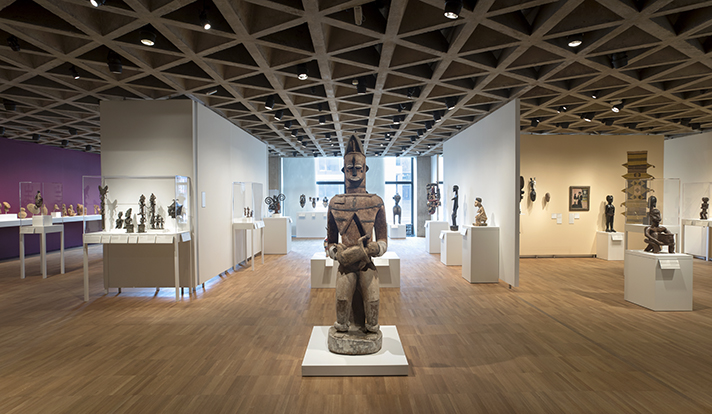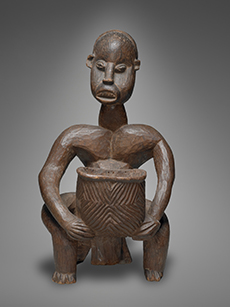A new location and a new focus for Yale’s African Art Collection

A new installation of African art at the Yale University Art Gallery presents objects from Africa’s earliest cultures along with pieces that inspired modernist artists like Pablo Picasso and Henri Matisse.
Relocated from the gallery’s second floor to a more prominent space on the ground level, the installation presents more than 250 objects, spanning 3,000 years, including sculpture, ceramics, masks, ivory carvings, and metalwork. The objects are arranged by various themes, offering viewers a sense of Africa’s complex and varied artistic traditions.
“We don’t attempt to represent all geographic areas,” said Barbara Plankensteiner, the Frances and Benjamin Benenson Foundation Curator of African Art, who organized the installation. “Instead, we have arranged the installation thematically to highlight the strengths of the collection and to allow visitors to explore the aesthetics, history, content, and local significance of the works on display.”

The new installation, housed in the Laura and James J Ross Gallery of African Art, features well-known pieces from the collection as well as items that have rarely been on view.
“Barbara has re-envisioned the collection of African art with an installation that privileges the formal qualities of the objects and opens up windows of possibility for teaching and learning,” said Pamela Franks, senior deputy director. “The groupings of artworks blend chronology and geography to create conversations around universal themes such as maternity, initiation, artistic influence, international trade, and the supernatural, yielding countless new opportunities for appreciation and understanding of the collection’s strengths, and of African art’s global connections.”
A section on antiquity features sculpture from several cultures arranged chronologically, beginning with five terracotta heads and busts from the Nok culture in Nigeria that date from 900 to 300 B.C.E. — among the earliest sculptural art on the continent outside of Egypt.
Discoveries made during recent archaeological excavations suggest the Nok sculptures were used in burial rituals, Plankensteiner said.
An adjacent section presents objects that demonstrate interconnections among African cultures, as well as ties between African and non-African cultures.
“Galleries traditionally focus on representing Africa as a closed continent with little relations with outside world,” Plankensteiner said. “There were widespread relations with Asia in the East and the Mediterranean to the North, which is reflected in the art on view in this section.”
 An elaborate Oliphant, a hunting horn carved from an elephant tusk, was produced by artists in Sierra Leone for Portuguese merchants in the 16th century. Its relief carvings depict European hunting scenes.
An elaborate Oliphant, a hunting horn carved from an elephant tusk, was produced by artists in Sierra Leone for Portuguese merchants in the 16th century. Its relief carvings depict European hunting scenes.
“We assume that the Portuguese merchants brought woodcuts to show the local artists imagery that they replicated on the horn,” Plankensteiner said.
Other intricately carved ivory tusks on display show Africans in European dress and slaves bound in chains.
Selections of metal objects made by craftsmen in the Benin Kingdom and the Ijebu Kingdom, both located in southern Nigeria, demonstrate further connections between African artists and Portuguese merchants and between these neighboring cultures.
Close trade relations with Portugal, and later with other European powers, brought unprecedented amounts of brass into the Benin Kingdom in exchange for pepper, ivory, and slaves. The trade made brass an important medium for artists in the royal court, Plankensteiner said.
The gallery’s central section examines iconography. A selection of female figures, including a large wood figure of a nursing mother at the gallery’s entrance, shows the importance that African artists placed on the feminine form, maternity, and fertility.
“The female image is a common theme,” Plankensteiner said. “We find that most depictions are of young females in their highest state of beauty, showing their readiness for marriage and to have children.”
By contrast, male imagery tended to focus on aggression, power, and strength, she said. For example, a grave marker for a prominent man in the Bongo culture of South Sudan has large notches for every large animal he killed during his lifetime.

A selection of animal masks on display includes images of antelopes, crocodiles, fish, and owls, among other beasts. The masks served a variety of functions, such as to teach moral or history lessons, protect communities and ward off evil, or entertain. The imagery was often a metaphor for human behavior, nature, or ancestral spirits, Plankensteiner said.
The local function of the art is explored in another section of the installation. Various pieces related to initiation practices are displayed, including a large body mask from Central Africa that was meant to protect initiation sites from evil forces. The mask is large and imposing but has a soft and caring face, which shows the need to protect and nurture the children undergoing initiation, Plankensteiner said.
This section also features objects that relate to religious practices and royal traditions.
The gallery’s final section concerns the history of Yale’s African art collection as well as the history of collecting African art in the United States.
Yale’s collection of African art, which consists of nearly 2,000 pieces, began with several gifts of textiles in 1937. The collection received a boost in 1954 with the acquisition of the collection of Ralph Linton, Sterling Professor of Anthropology, purchased as a gift by Mr. and Mrs. James M. Osborn in 1954. Another major milestone occurred in 2004 when Yale acquired as a gift the collection of the late Charles B. Benenson ’33, a real estate developer and passionate art collector. Benenson had amassed a world-class collection of nearly 600 objects, which now form the core of Yale’s collection.
 A figure from Benenson’s collection of a man seated with a bowl formerly belonged to the Dada artist Tristan Tzara and was exhibited at the Museum of Modern Art, New York, in 1935 in the influential exhibition “African Negro Art.”
A figure from Benenson’s collection of a man seated with a bowl formerly belonged to the Dada artist Tristan Tzara and was exhibited at the Museum of Modern Art, New York, in 1935 in the influential exhibition “African Negro Art.”
“This is an iconic piece for that moment in history,” Plankensteiner said of the wood figure, which was produced in Cameroon in the late 19th century.
That figure, along with others on view, were the kinds of pieces that modernist artists like Picasso had studied while searching for new visual language in their art.
“They were not much interested in the content of the art but more in the form and the way the human body was depicted, which they then used in their own work,” Plankensteiner said. “It was a very important moment in the development of modern art in Europe, and later in the United States.”
Collectors, like Benenson, began to acquire the types of pieces that had fascinated and inspired the modernist artists. They still shape people’s conception of African art, Plankensteiner said.
The Yale University Art Gallery, located at 1111 Chapel St. (between York and High), is open to the public free of charge 10 a.m.–5 p.m. Tuesday-Friday; until 8 p.m. on Thursdays from September to June; and 11 a.m.–5 p.m. Saturday-Sunday. It is closed Mondays and major holidays. For more information, visit the museum’s website.
Written by Mike Cummings for Yale News